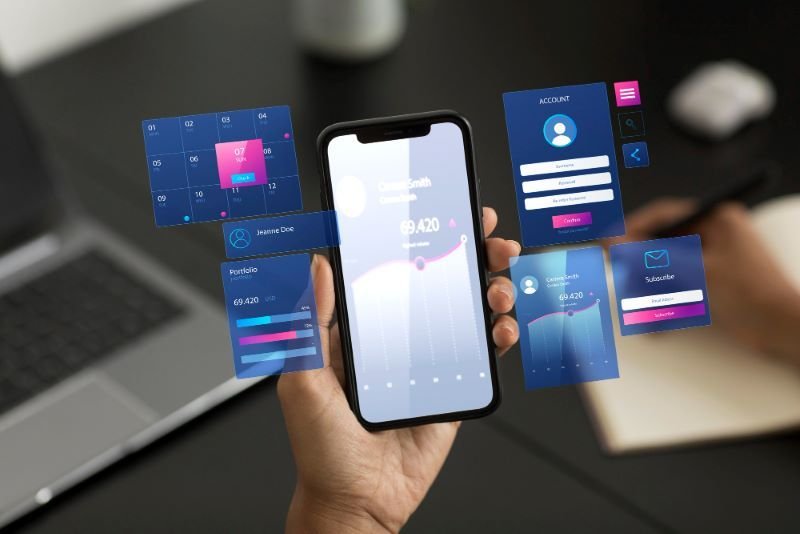In the ever-evolving world of financial technology, fintech mobile app development continues to revolutionize the way individuals and businesses interact with financial services. With 2025 approaching, the demand for feature-rich, user-friendly, and secure fintech apps is higher than ever. To stay ahead of the curve, developers and businesses must focus on integrating cutting-edge functionalities that cater to modern users’ needs. Here are the key features every fintech mobile app must have in 2025 to remain competitive and relevant.
1. Biometric Authentication for Enhanced Security
Security remains a top priority in fintech mobile app development. Biometric authentication methods, such as fingerprint scanning, facial recognition, and iris scanning, provide a robust layer of security while ensuring a seamless user experience. These features reduce reliance on passwords, which are often vulnerable to breaches, and make logging into accounts faster and more secure.
In 2025, biometric authentication will be a non-negotiable feature, especially with rising concerns about cyber threats and data breaches. By implementing multi-factor authentication (MFA) that combines biometrics with traditional methods like OTPs, fintech apps can offer unparalleled security.
2. AI-Powered Personalized Insights
Artificial Intelligence (AI) is transforming the fintech landscape by enabling personalized financial insights for users. AI algorithms can analyze users’ spending habits, savings patterns, and investment behavior to provide tailored recommendations. These insights help users make informed financial decisions, such as budgeting effectively or investing wisely.
For instance, AI-driven chatbots can answer customer queries in real time, guide users through financial processes, and provide proactive alerts about account activity or market trends. Such features make fintech apps more interactive and valuable to their users.
3. Blockchain Integration for Transparency and Security
Blockchain technology is revolutionizing how financial transactions are conducted. By integrating blockchain, fintech mobile apps can offer secure, transparent, and tamper-proof transaction records. This is particularly beneficial for applications involving peer-to-peer payments, digital wallets, and cryptocurrency trading.
In 2025, blockchain integration will be essential for gaining users’ trust, especially in regions where financial fraud and corruption are prevalent. Features such as smart contracts and decentralized finance (DeFi) platforms will further enhance the app’s appeal to tech-savvy users.
4. Real-Time Payments and Transfers
Today’s users expect instant gratification, and fintech apps are no exception. Real-time payment capabilities have become a must-have feature for seamless financial transactions. Whether it’s transferring money to a friend, paying bills, or making international payments, the ability to execute transactions in real-time enhances user satisfaction.
With advancements in payment technologies like RTP (Real-Time Payment) systems and APIs, fintech mobile app development is making instant payments more reliable and accessible than ever before.
5. Multi-Currency Wallets for Global Transactions
As globalization grows, users demand financial solutions that transcend borders. Multi-currency wallets enable users to hold, transfer, and exchange multiple currencies within a single app. This feature is particularly useful for businesses, frequent travelers, and those involved in international trade.
Incorporating competitive exchange rates and real-time currency conversion into the wallet can significantly enhance its functionality. Furthermore, integrating support for cryptocurrencies can attract a wider audience interested in digital assets.
6. User-Centric Design and Intuitive Interface
No matter how advanced the features are, a fintech app’s success hinges on its usability. A user-centric design with an intuitive interface ensures that users can navigate the app effortlessly, even if they’re not tech-savvy. Simple layouts, clear instructions, and minimalistic aesthetics contribute to a superior user experience.
Features like dark mode, customizable dashboards, and quick access shortcuts can make the app more appealing. Conducting user testing during development can provide insights into improving the design and functionality further.
7. Regulatory Compliance and Reporting Tools
Compliance with financial regulations is non-negotiable in fintech mobile app development. Features that ensure adherence to laws such as GDPR, PSD2, and AML (Anti-Money Laundering) regulations are critical. Integrating automated reporting tools can streamline compliance processes and reduce the risk of penalties.
In 2025, apps that proactively educate users about compliance measures and offer transparency about how their data is used will build greater trust and loyalty.
8. Investment and Wealth Management Tools
Fintech apps are no longer limited to payments and transfers. Many now offer comprehensive investment and wealth management tools that cater to both beginners and seasoned investors. Features such as portfolio tracking, robo-advisors, and market analysis tools empower users to grow their wealth efficiently.
Incorporating educational resources like tutorials, webinars, and financial news updates can further enhance the app’s value proposition.
9. Voice Recognition and Command Features
Voice technology is gaining traction in fintech mobile app development. Voice recognition and command features allow users to perform tasks like checking their account balance, making transactions, or setting up reminders without typing. This hands-free approach is particularly useful for busy professionals and visually impaired users.
By leveraging AI-powered natural language processing (NLP), fintech apps can make voice interactions more accurate and conversational in 2025.
10. Data Analytics for Enhanced Decision-Making
Data analytics tools integrated into fintech apps enable both users and businesses to make data-driven decisions. Users can access detailed reports on their spending patterns, savings progress, and investment performance, while businesses can gain insights into customer behavior and market trends.
Advanced analytics dashboards, powered by AI, can provide predictive insights that help users anticipate future expenses and investments. Such features not only improve user satisfaction but also position the app as a valuable financial partner.
11. Seamless Integration with Third-Party Services
Fintech apps in 2025 must integrate seamlessly with other platforms and services to provide a holistic experience. Whether it’s linking with accounting software, e-commerce platforms, or loyalty programs, interoperability enhances convenience and usability.
APIs play a critical role in enabling these integrations. For example, integrating with popular accounting tools like QuickBooks or Xero can attract small business owners to use the app for their financial needs.
12. Gamification for User Engagement
Gamification is an emerging trend in fintech mobile app development that enhances user engagement by making financial management fun and rewarding. Features like achievement badges, savings challenges, and leaderboards motivate users to meet their financial goals.
By turning mundane tasks into interactive experiences, gamification not only retains users but also fosters long-term loyalty.
Conclusion
In 2025, fintech mobile app development will be defined by its ability to combine innovation with user-centric features. From biometric authentication and AI-driven insights to blockchain integration and gamification, these key features are essential for meeting user expectations and staying competitive in a dynamic industry.
Businesses venturing into fintech mobile app development must prioritize security, usability, and compliance while embracing emerging technologies to create solutions that resonate with modern users. By doing so, they can not only capture a larger market share but also revolutionize how financial services are delivered in the digital age.



